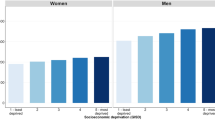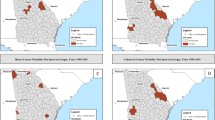Abstract
Cancer is a leading cause of death in the Appalachian region of the United States. Existing studies compare regional mortality rates to those of the entire nation. We compare cancer mortality rates in Appalachia to those of the nation, with additional comparisons of Appalachian and non-Appalachian counties within the 13 states that contain the Appalachian region. Lung/bronchus, colorectal, female breast and cervical cancers, as well as all cancers combined, are included in analysis. Linear regression is used to identify independent associations between ecological socioeconomic and demographic variables and county-level cancer mortality outcomes. There is a pattern of high cancer mortality rates in the 13 states containing Appalachia compared to the rest of the United States. Mortality rate differences exist between Appalachian and non-Appalachian counties within the 13 states, but these are not consistent. Lung cancer is a major problem in Appalachia; most Appalachian counties within the 13 states have significantly higher mortality rates than in-state, non-Appalachian counterparts. Mortality rates from all cancers combined also appear to be worse overall within Appalachia, but part of this disparity is likely driven by lung cancer. Education and income are generally associated with cancer mortality, but differences in the strength and direction of these associations exist depending on location and cancer type. Improving high school graduation rates in Appalachia could result in a meaningful long term reduction in lung cancer mortality. The relative importance of household income level to cancer outcomes may be greater outside the Appalachian regions within these states.

Similar content being viewed by others
References
Appalachian Regional Commission. (2011). Appalachian Regional Commission History. http://www.arc.gov/about/ARCHistory.asp.
Hutson, S. P., Dorgan, K. A., Phillips, A. N., & Behringer, B. (2007). The mountains hold things in: The use of community research review work groups to address cancer disparities in Appalachia. Oncology Nursing Forum, 34(6), 1133–1139.
Cossman, J. S., Cossman, R. E., & James, W. L. (2007). Persistent clusters of mortality in the United States. American Journal of Public Health, 97(12), 2148–2150.
Behringer, B., & Friedell, G. H. (2006). Appalachia: Where place matters in health. Preventing Chronic Disease, 3(4), 1–4.
Dignan, M., Paskett, E., & Lengerich, E. (2010). Addressing the cancer burden in Appalachian communities. Appalachia Community Cancer Network.
Gregg, D. B. (2006). Cancer mortality disparities in Central Appalachia: Kentucky, Tennessee and Virginia counties. Rural Appalachian Cancer Demonstration Program. http://www.etsu.edu/kellogg/Documents/(12)%20Data%20Based%20Disparities%20article.pdf.
Halverson, J. A., Ma, L., & Harner, E.J. (2004). An analysis of disparities in health status and access to health care in the Appalachian region. Prepared for Appalachian Regional Commission. http://www.arc.gov/research/researchreportdetails.asp?REPORT_ID=82.
Lengerich, E. J., Wyatt, S.W., & Rubio, A. (2004). The Appalachian cancer network: Cancer control research among a rural, medically underserved population. Journal of Rural Health, Spring, 181–187.
Huang, B., Wyatt, S. W., Tucker, T. C., Bottorff, D., Lengerich, E., & Hall, H. I. (2002). Cancer death rates—Appalachia, 1994–1998. Morbidity and Mortality Weekly Report, 51(24), 527–529.
Yabroff, K. R., Lawrence, W. F., & King, J. C. (2005). Geographic disparities in cervical cancer mortality: What are the roles of risk factor prevalence, screening, and use of recommended treatment. Journal of Rural Health, Spring, 149–157.
Yost, K., Perkins, C., & Cohen, R. (2001). Socioeconomic status and breast cancer incidence in California for different race/ethnic groups. Cancer Causes and Control, 12(8), 703–711.
Appalachian Regional Commission. Poverty Rates, 2005–2009. (2010). www.arc.gov/reports.
Brodish, P. H., Massing, M., & Tyroler, H. A. (2000). Income inequality and all-cause mortality in the 100 counties of North Carolina. Southern Medical Journal, 93(4), 386–391.
Ward, E., Jemal, A., & Cokkinides, V. (2004). Cancer disparities by race/ethnicity and socioeconomic status. CA: A Cancer Journal for Clinicians, 54, 78–93.
Freeman, H. P. (2004). Poverty, culture, and social injustice: Determinants of cancer disparities. CA: A Cancer Journal for Clinicians, 54, 72–77.
Bradley, C. J., Given, C. W., & Roberts, C. (2001). Disparities in cancer diagnosis and survival. Cancer, 91(1), 178–188.
Robert Wood Johnson Foundation. (2009). Education and health, 1–15. www.commissiononhealth.org.
Appalachian Regional Commission. (2005). Education—high school and college completion rates, 2000. www.arc.gov/data.
Albano, J. D., Ward, E., & Jemal, A. (2007). Cancer mortality in the United States by education level and race. Journal of the National Cancer Institute, 99, 1384–1394.
Meara, E., Richards, S., & Cutler, D. (2008). The gap gets bigger: Changes in mortality and life expectancy by education, 1981–2000. Health Affairs, 27(2), 350–360.
Eberhardt, M. S., & Pamuk, E. R. (2004). The importance of place of residence: Examining health in rural and nonrural areas. American Journal of Public Health, 94(10), 1682–1686.
Baldwin, L. M., Cai, Y., Larson, E. H., et al. (2008). Access to cancer services for rural colorectal cancer patients. Journal of Rural Health, 24(4), 390–399.
Murray, C. J. L., Kulkarni, S. C., & Michaud, C. (2006). Eight Americas: Investigating mortality disparities across races, counties, and race-counties in the United States. PLoS Medicine, 3(9), 1–12.
Mackenbach, J. P., Bos, V., & Anderson, O. (2003). Widening socioeconomic inequalities in mortality in six Western European countries. International Journal of Epidemiology, 32, 830–837.
O’Malley, C. D., Le, G. M., & Glaser, S. L. (2003). Socioeconomic status and breast carcinoma survival in four racial/ethnic groups. Cancer, 97(5), 1303–1311.
Ezzati, M., Friedman, A. B., Kulkarni, S. C., & Murray, C. J. L. (2008). The reversal of fortunes: Trends in county mortality and cross-county mortality disparities in the United States. PLoS Medicine, 5(4), 1–12.
Bronstein, J. M., Ounpraseuth, S., & Jonkman, J. (2011). Improving perinatal regionalization for preterm deliveries in a Medicaid covered population: Initial impact of the Arkansas ANGELS intervention. Health Services Research, 46(4), 1082–1103.
Surveillance, Epidemiology, and End Results (SEER) Program. (2011). National Cancer Institute, DCCPS, Surveillance Research Program, Cancer Statistics Branch. www.seer.cancer.gov.
Chenowith, E., & Galliher, R. V. (2004). Factors influencing college aspirations of rural West Virginia high school students. Journal of Research in Rural Education, 19(2), 1–14.
Kindig, D. A., Seplaki, C. L., & Libby, D. L. (2002). Death rate variation in US subpopulations. Bulletin of the World Health Organization, 80(1), 9–15.
Pollard, K. M. (2004). A new diversity: Race and ethnicity in the Appalachian region. Series on demographic and socioeconomic change in Appalachia. Washington, DC: Population Reference Bureau and Appalachian Regional Commission.
Frohlich, N., Carriere, K. C., Potvin, L., & Black, C. (2001). Assessing socioeconomic effects on different sized populations: To weight or not to weight? Journal of Epidemiology and Community Health, 55, 913–920.
Bepler, G. (1999). Lung cancer epidemiology and genetics. Journal of Thoracic Imaging, 14(4), 228–234.
Mao, Y., Hu, J., Ugnat, A. M., Semenciw, R., & Fincham, S. (2001). Socioeconomic status and lung cancer risk in Canada. International Journal of Epidemiology, 30, 809–817.
Hendryx, M., O’Donnell, K., & Horn, K. (2008). Lung cancer mortality is elevated in coal mining areas of Appalachia. Lung Cancer, 62, 1–7.
Wingo, P. A., Tucker, T. C., Jamison, P. M., et al. (2008). Cancer in Appalachia, 2001–2003. Cancer, 112(1), 181–192.
Ferketich, A. K., Liber, A., Pennell, M., Nealy, D., Hammer, J., & Berman, M. (2010). Clean indoor air ordinance coverage in the Appalachian region of the United States. American Journal of Public Health, 100(7), 1313–1318.
Ahijevych, K., Kuun, P., & Christman, S. (2003). Beliefs about tobacco among Appalachian current and former users. Applied Nursing Research, 16(2), 93–102.
Meyer, M. G., Toborg, M. A., Denham, S. A., & Mande, M. J. (2008). Cultural perspectives concerning adolescent use of tobacco and alcohol in the Appalachian mountain region. Journal of Rural Health, 24(1), 67–74.
Acknowledgments
Funding for this project was provided by a grant through an Interagency Agreement between the Appalachian Regional Commission and the Centers for Disease Control and Prevention # CO—15409. The authors would like to thank Deborah Gregg, Rachel Ward and Jim Anderson for reviews and comments.
Author information
Authors and Affiliations
Corresponding author
Rights and permissions
About this article
Cite this article
Blackley, D., Behringer, B. & Zheng, S. Cancer Mortality Rates in Appalachia: Descriptive Epidemiology and an Approach to Explaining Differences in Outcomes. J Community Health 37, 804–813 (2012). https://doi.org/10.1007/s10900-011-9514-z
Published:
Issue Date:
DOI: https://doi.org/10.1007/s10900-011-9514-z




